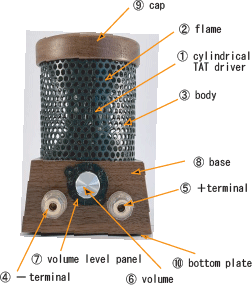




| TAKET-LIVE | ||||||||||||||
|
■ Cylindrical TAT driver creates three-dimensional stage ■ It cut below 20kHz to achieve a transparent sound ■ Combining lively vivid-sounds and sound-stage ■ Uses a natural wood cabinet ■ Let customise for your favorite sound-quality |
||||||||||||||
|
JPY 132,000 ( pair ) |
||||||||||||||
| Main Specifications
1. Drive system : Cylindrical TAT driver (TAKET's unique drive system. See technology page) 2. Minimum impedance : 200 ohms 3. Frequency response ; 20kHz - 100kHz 4. Directivity ; 360° (omnidirectional) 5. Volume position ; 1 to 7 and 7 over (the position turned further from 7 is 7 over) 6. Sensitivity ; Volume figures are the main speaker's sesitivity which will introduce natural |
||||||||||||||
| 7. Mass ; about 265 gram Size ; Width ; about 75 mm ,Height ; about 112 mm, Depth about 88 mm( terminal inclouded ) a. Base and Cap ; walnut wood, urethane clear matte coating b. Body ; SPCC perforated metal with quenching matte c. Comparison photo of BATPRO2 and TAKET-LIVE |
||||||||||||||
|
||||||||||||||
Usage method |
||||||||||||||
| TAKET-LIVE back | 1. Connection method ; Please connect the + and - terminals of your speaker and TAKET-LIVE by speaker cables each other. If your speaker has more than 2-way terminals, connect to the highest frequency terminals You can also connect directly to the output terminal of the amplifier. There are rare speakers with + and - reversed. In that case, it is better to reverse the + and - connections of TAKET-LIVE "Please try it once." 2. Adjustment of the sound pressure level; Intuitively, the levels can be expressed as follows. |
|||||||||||||
 |
||||||||||||||
| TAKET-LIVE can be customised to your favorite sound-quality and sound-stage. |
||||||||||||||
| Please refer here. | ||||||||||||||